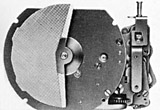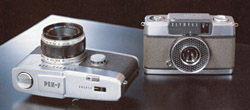
| home |

 |
|||
|
Maitani had been keeping a serious attitude to his work after the accomplishment of the Pen camera. He pursued two concepts in the development of the Pen series. One was the sophisticated secondary camera for Leica camera users. And the other was the simple camera for general people. Pen EE was released in 1961. Maitani attempted a bold idea in the development of the Pen EE. It has an automatic exposure system using selenium light cell. The shutter speed is 1/60sec fixed and the variable aperture is automatic. The photographer only needs to set the film sensitivity. It makes picture taking by just pushing a button possible. |
|||
|
Maitani
: |
|||
|
Because of its simplicity, the Sales Department strongly opposed the Pen EE. However, the executives changed their attitude quite abruptly after they saw the prototype. "Way to go! This can be priced at 10,000 Yen!" The Sales Department added 2,000Yen to the Maitani's estimation of 8,000Yen. A year later, Pen EES with two shutter speeds of 1/30 and 1/250sec was released. The shutter was produced by Olympus. Pen EES is the world's first programmed automatic exposure camera. |
|||
 |
||
|
This automation was successful and made an unprecedented hit in the market. Olympus couldn't meet the huge demand. The Sales Department inquired to the factory everyday about the production schedule to stock just one more camera for the enormous back orders. The Pen series total production amount reached about 17,000,000 units in 20 years. And more than half of them, about 9,000,000 units, were Pen EE and Pen EES. It was an enormously large sales. Camera was popularized all at once, it pervaded among women just as Maitani wanted. The Olympus Pen name was featured in a commercial song on radio and TV. It was a common scene to hear children chanting the melody "Pen, Pen, Pen, Pen" to themselves while playing. Ihee Kimura, one of the great Japanese photographers tells an occasion with the Pen camera. "I witnessed a woman was taking a picture of her baby in her arm at a terrace house." ( from the discussion "The way of Japanese camera after the 2nd World War", Nihon Camera magazine.) |
||
 |
| In 1963 Pen-F was released. There was constant friction between Maitani and others in the past. But this time, nobody obstructed the development of the Pen-F. It was started with everybody's great expectations of a half-frame SLR. He didn't need to iron out the different opinions and the plan was smoothly approved. Half frame SLR could meet the demands of times. Maitani always says the Pen-F was developed in a good environment. |
|
Maitani: |
|||
| Even
so, there were still many technical difficulties and trial and error was
repeated. The length of the reflex mirror is half of that of 35mm SLR. And the distance between the back of the lens and the film surface is closer. In a conventional design, the reflex mirror, which swings vertically, interferes the rear of the lens. In the Pen-F, the reflex mirror swings horizontally like a fish's caudal fin. The focusing screen is at the side of mirror. And a Porro prism system was invented to reflect image up to the viewfinder. |
|
||||
|
The rotary metal focal plane shutter is also a new invention. The 170 degree fan-shaped shutter is made of titanium.To design a rotary shutter with a fast shutter speed was a hard work. At the beginning, the top shutter speed achieved was an unthinkable 1/60sec. The way to increase the speed was to the reduce the weight of the disk. Usually thin steel sheet was used for apertures and shutters, it was too heavy to rotate faster. So the development team tried aluminum. When the shutter was stopped, the sudden force caused a massive shock and the aluminum sheet crumpled like a sheet of paper. Next material tried was titanium. The shutter speed was able to increase to 1/300sec. But it still wasn't fast enough. If the the titanium was thinner, it was not strong enough. To make the disk even lighter but with the same strength, a technology used in microscope manufacturing was applied. The titanium was etched in the center leaving it thick at the circumference. The speed of 1/500sec was achieved when the spring was strengthened. But the spring would break after a few repetitions due to metal fatigue. Finally the problem was solved by using a special spring made of Swedish steel. |
 |
||||
|
Maitani: |
|||
|
|
|||
|
"Excellent!"
This is what the three Leitz engineers said after they examined the Pen-
F for about two hours during the 1963 Photokina. |
|||
|
Maitani: |
|||
|
Eiichi
Sakurai: |
|||
 |
|
Camera industry was in the forefront when Maitani was developing the Pen series. It is similar to computer software industry of today. New products always had high news value. |
|||
|
Maitani: |
|||

|
| pen
1| pen 2 | another
perspective | scene
from the interview | literature
|
| chrono
| young Maitani | joining
Olympus | philosophy | anecdotes
l Maitani adv | Pen
|
OM | XA | photo
|